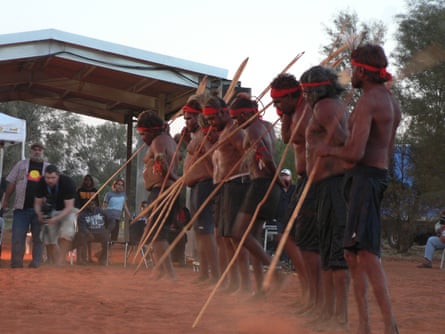On the eastern side of Uluru, in the Anangu community of Mutitjulu, more than 200 delegates from Aboriginal and Torres Strait Islander communities throughout Australia gathered to mark the start a historic meeting that aims to shape the future of the relationship between Australia and its first peoples.
Children played on the edges of a ceremony ground of raked red dirt where ceremonial performers from three Indigenous nations officially opened the talks.

Mutijulu is both a symbol of what the meeting hopes to achieve, and a warning. It is wholly Anangu-owned and controlled, handed back to the traditional owners by the Hawke government in 1985.
Anangu also own the Uluru-Kata Tjuta National Park, co-managed with Parks Australia. The ownership of the traditional lands provides and economic base for the community and allows elders cultural control of the sacred sites that dot both Uluru and Kata-Tjuta, which are world heritage listed for both their natural and cultural values.
But it also one of the centres of the Northern Territory intervention, prompted by allegations of violence and sexual abuse.
Land rights, self-determination, improved social and emotional wellbeing, and freedom from race-based federal government interventions are among the priorities Aboriginal and Torres Strait Islander peoples will be fighting for when the national convention on constitutional Recognition begins at nearby Ayers Rock Resort on Wednesday.

Seventeen delegates from each of the 12 meetings held around the country in the past six months, as well as the 16-member Referendum Council and other Indigenous leaders, will seek to form a consensus position on constitutional recognition to present to government in the Referendum Council final report in June.
The three-day dialogue will build on the already agreed-upon position that recognition must be “substantive and practical.”
Options being discussed include a statement of acknowledgement of Aboriginal and Torres Strait Islander peoples as the first Australians, either contained within the constitution or enshrined separately; and amending or deleting s.51 xxvi of the Australian constitution, which gives the federal government power to make laws for “the people of any race for whom it is deemed necessary to make special laws.”
Other key options include inserting a constitutional prohibition against racial discrimination; removing s.25 of the constitution, which allows for the possibility of any particular group of people being excluded from voting in a state election; and providing for an Indigenous voice to be heard in parliament.
According to a statement made by 40 Indigenous leaders following a preliminary meeting on recognition with the then prime minister Tony Abbott and opposition leader Bill Shorten in 2015, a “minimalist approach,” of just a preamble, modified s.51 xxvi and deleted s.25 would not be acceptable.

At the opening ceremony of the talks at Mutitjulu on Tuesday, Gumatj spokesman Djunga Djunga Yunupingu presented Mutitjulu elders with a flame, in the form of a ceremonial fire dance, and said that the fire was intended to light the way for the discussions ahead.
“Our fire was lit by our ancestors and lives through our song and our dance,” he said. “This give us power and we seek to give that power to you.”
Yunupingu said that Aboriginal and Torres Strait Islander peoples were linked “throughout the country by song lines and kinship” and were honoured to be “in the presence of the greatest rock of all, Uluru, our heart and the heart of our nation.”
“We all know you have suffered much and hurtful things have happened to you, but you are still here, and just now we have tried to honour you for your strength and for your survival … you can now go and light a fire in the nation for all of us, for our future, for our children, for all Australians.”
Gumatj dancers were followed by Mualgau Lak Gubau Gizu from Thursday Island, who told danced the movement of the shark constellation, recognised by western astronomers as the Big Dipper and part of the Ursa Major, which signals the start of shark hunting season.

The ceremony ended with Inmas from Mutitjulu, who danced a men’s dance, a war song, from creation times. The children of Mutitjulu, who had been diving into the soft dirt between dances, raced on to the ceremonial ground with a football, drawing smiles from many of the delegates.
It is their future, after all.

Comments (…)
Sign in or create your Guardian account to join the discussion